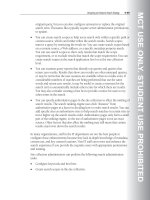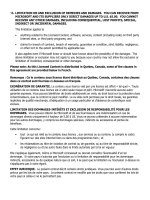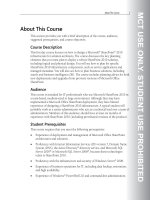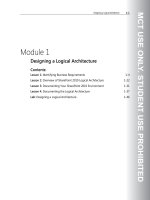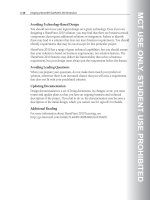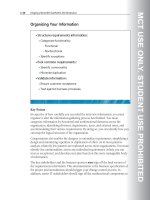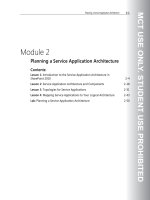Designing a Microsoft SharePoint 2010 Infrastructure Vol 1 part 6 pdf
Bạn đang xem bản rút gọn của tài liệu. Xem và tải ngay bản đầy đủ của tài liệu tại đây (757.96 KB, 10 trang )
MCT USE ONLY. STUDENT USE PROHIBITED
1-20 Designing a Microsoft® SharePoint® 2010 Infrastructure
Organizing Your Information
Key Points
Irrespective of how carefully you recorded the interview information, you must
organize it after the information-gathering process has finished. You must
categorize information by functional and nonfunctional elements across the
organization, identifying divisions, departments, users, and external users, and
accommodating their various requirements. By doing so, you can identify how you
can map the logical structure of the organization.
Categorization also enables the designer to rationalize requirements, simplifying a
design and minimizing repetition or duplication of effort. As in most patterns
analysis, relatively few patterns are replicated across most organizations. You must
identify the commonalities, assess any individual requirements (which you can
treat as exceptions), and develop your plan based on this more manageable body
of information.
The key stakeholders and the business sponsor must sign off the final version of
the requirements information. This documentation is the business specification of
the project and amendments should trigger your change control process. In
addition, senior IT stakeholders should sign off the nonfunctional components to
MCT USE ONLY. STUDENT USE PROHIBITED
Designing a Logical Architecture 1-21
ensure that the elements of your requirements that do not relate to SharePoint
2010, such as security or network performance, are agreed.
MCT USE ONLY. STUDENT USE PROHIBITED
1-22 Designing a Microsoft® SharePoint® 2010 Infrastructure
Lesson 2
Overview of SharePoint 2010 Logical
Architecture
The logical architecture of your business is the basis for your design. When you
have gathered the business requirements, you must map these against the
SharePoint 2010 logical architecture. This module provides an overview of the key
logical architecture components in SharePoint 2010. Using this information, you
can make key decisions about how SharePoint 2010 can service your business
requirements.
Objectives
After completing this lesson, you will be able to:
• Define logical architecture.
• List the SharePoint 2010 logical architecture components.
• Describe hosting and multi-tenancy.
MCT USE ONLY. STUDENT USE PROHIBITED
Designing a Logical Architecture 1-23
What Is a Logical Architecture?
Key Points
Most new solution architects focus on physical hardware design, rather than the
logical architecture. This is often easier for new architects to understand because
they are more familiar with specifying physical system properties such as disk
capacity or memory.
The logical architecture documents the nonphysical structure of a solution,
designed to fulfill business requirements.
The logical architecture does not specify any server-related functionality such as
the amount or size of server hardware. Rather, it reflects requirements such as
separation of departmental information or user access. These requirements do not
relate to any given technologies or platforms. Although you may identify the need
for databases, a logical architecture design does not specify a predefined database
engine.
One of the most important aspects of a logical architecture design is that
stakeholders should recognize it as a true reflection of their business; otherwise
they cannot agree to sign off your design. This means that you must provide
MCT USE ONLY. STUDENT USE PROHIBITED
1-24 Designing a Microsoft® SharePoint® 2010 Infrastructure
information in a nontechnical format that clearly documents business
requirements.
This course is about designing SharePoint 2010 solutions, but this should not
influence your logical architecture design, which should be solution-agnostic.
However, you should recognize the requirements that may relate to SharePoint
2010 and where other solutions may need to integrate to service business
requirements.
MCT USE ONLY. STUDENT USE PROHIBITED
Designing a Logical Architecture 1-25
SharePoint 2010 Logical Architecture Components
Key Points
The SharePoint 2010 logical architecture has several core components that will
influence your design.
Server Farms
A server farm represents the top-level element of a design.
Several criteria that your organization determines may affect the number of server
farms that are required, including:
• Separate operational divisions of responsibility.
• Dedicated funding sources.
• Separate data center locations.
• Regulatory requirements for physical isolation between sites.
MCT USE ONLY. STUDENT USE PROHIBITED
1-26 Designing a Microsoft® SharePoint® 2010 Infrastructure
However, you can satisfy many isolation requirements on a single server farm. For
example, you can use different Internet Information Services (IIS) application
pools with different process identities to achieve isolation at the process level for
both sites and service applications.
Service Applications
A service application provides a resource, or resources, that can be shared across
sites in a farm or across multiple farms.
In Microsoft Office SharePoint Server 2007, service resources were shared in the
Shared Services Provider (SSP). This architecture has changed in SharePoint 2010
to provide greater flexibility and granularity of service. The service infrastructure is
now implemented in Microsoft SharePoint Foundation 2010 and SharePoint 2010.
You can design and deploy individual services independently, and you can add
third-party services to your solution. This means that you can deploy only the
services—service applications—that are required to a farm.
Service applications are associated with Web applications and can have various
configurations:
• Web applications can use only the services that are required, rather than
deploying all services to all Web applications irrespective of whether they will
be used.
• You can design multiple instances of the same service in a farm and assign
unique names to each.
• You can share service applications across multiple Web applications in the
same farm.
• You can share some service applications across farms.
Application Pools
In IIS 7.0, an application pool is a group of one or more URLs that a worker
process or set of worker processes serves.
When you create Web applications and services in SharePoint 2010 products, you
can either select a pre-existing application pool to use or create a new one. Each
application pool has its own worker process and can have a separate identity
(security account), which prevents two processes from interacting.
Web Applications
A Web application is an IIS Web site that SharePoint 2010 creates and uses. You
can extend a Web application up to four times to create additional zones in
MCT USE ONLY. STUDENT USE PROHIBITED
Designing a Logical Architecture 1-27
SharePoint 2010, which results in up to five IIS Web sites that are associated with a
single Web application. Each IIS Web site is associated with a different zone and
you can assign a unique domain name to each.
Zones
Zones represent different logical paths (URLs) to gain access to the same Web
application. In each Web application, you can create up to five zones by using one
of the available zone names: Default, Intranet, Internet, Custom, or Extranet. This
division into zones enables you to provide more than one URL for user access,
which enables you to provide multiple authentication options.
The Default zone is the zone that is first created when a Web application is created.
You can create the other zones by extending a Web application.
Content Databases
By default, all content for a Web application is stored in one content database. You
can separate content into multiple content databases at the site collection level. A
content database can include one or more site collections. A single site collection
cannot span multiple databases.
Site Collections
A site collection is perhaps the most important SharePoint logical design element.
Site collections are a logical set of SharePoint sites that share the same top-level site
and certain administrative settings. Each site collection contains exactly one top-
level Web site and zero or more subsites. Site collections are the highest level of
logical containment within SharePoint; files and other items cannot be stored at
any level higher than a site collection. In addition, site collections are autonomous
and independent of each other; each site collection has its own security model,
storage location, and configuration settings.
Sites
A site is a logical unit of containment that contains lists and libraries, permission
levels, and configuration settings. Typically, a site is represented by one or more
Web pages, which visually display Web Parts and other UI content. Each site can
define its own security or can inherit from its parent. Sites are contained within a
site collection.
Lists and Libraries
A list (or library) is a logical container that holds a collection of similar items such
as contacts, appointments, and documents. Each list or library contains a number
of columns of various data types (for example, text and date). Lists also contain
configuration settings, permission levels, and views.
MCT USE ONLY. STUDENT USE PROHIBITED
1-28 Designing a Microsoft® SharePoint® 2010 Infrastructure
Items
An item is the most granular logical element in SharePoint, and represents a
singular unit of content. For example, an item could be a document, a contact, or a
custom row of data.
MCT USE ONLY. STUDENT USE PROHIBITED
Designing a Logical Architecture 1-29
Hosting and Multi-Tenancy
Key Points
You can define hosting and multi-tenancy as follows:
• Hosting. The provision of distinct SharePoint 2010 services to a group, usually
an external organization.
• Multi-tenancy. The architectural principle where a single instance of the
software serves multiple client organizations (tenants).
Multi-tenancy is primarily designed for hosting companies, who supply SharePoint
services to external—tenant—customers. Administrators can deploy and manage
features and services while giving tenants control over the usage and experience.
Multi-tenancy relies on site subscriptions and subscription IDs. Tenant site
collections are grouped together by site subscription based on a common ID. The
subscription ID maps features and services and also partitions service data
according to tenant.
One or more of the following factors usually drive the inclusion of internal hosting
in a business deployment:
